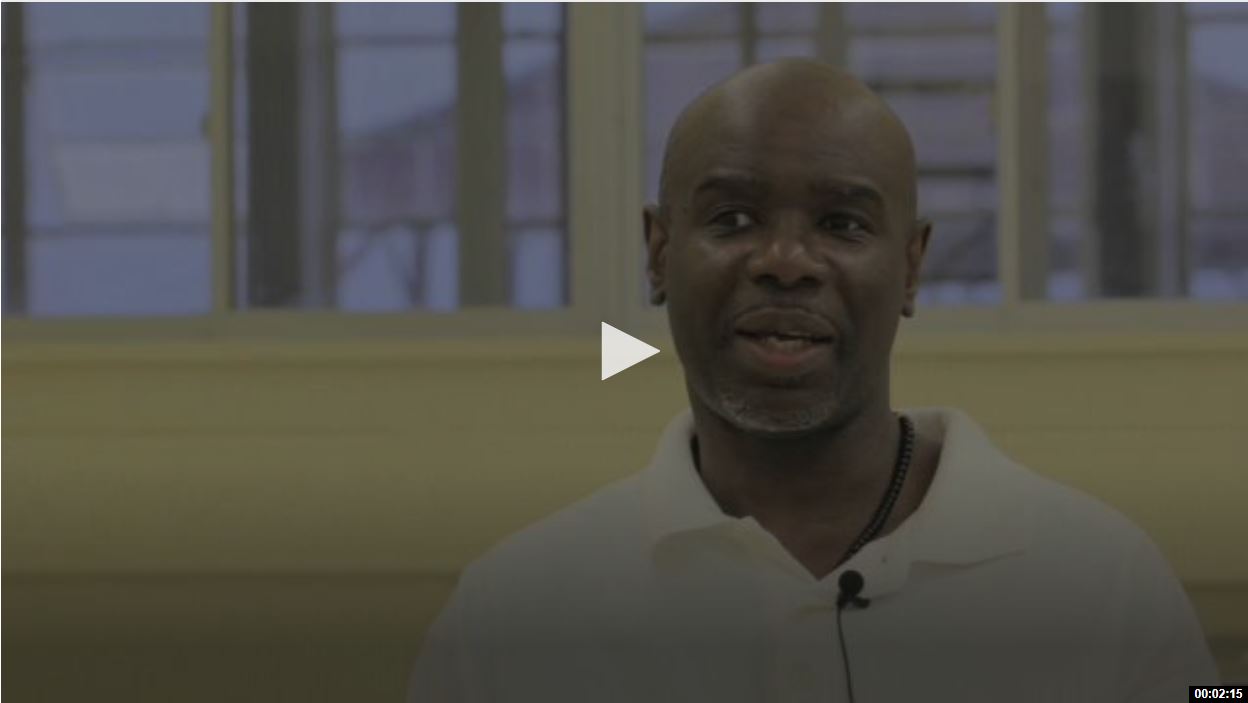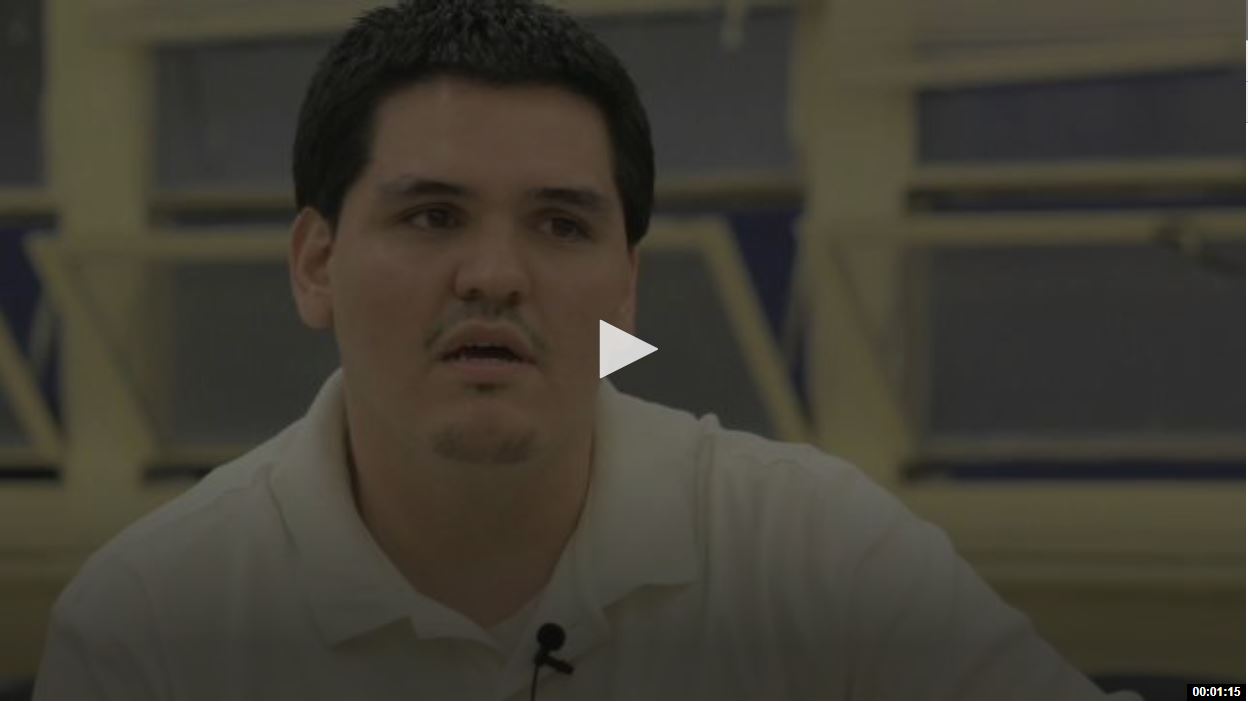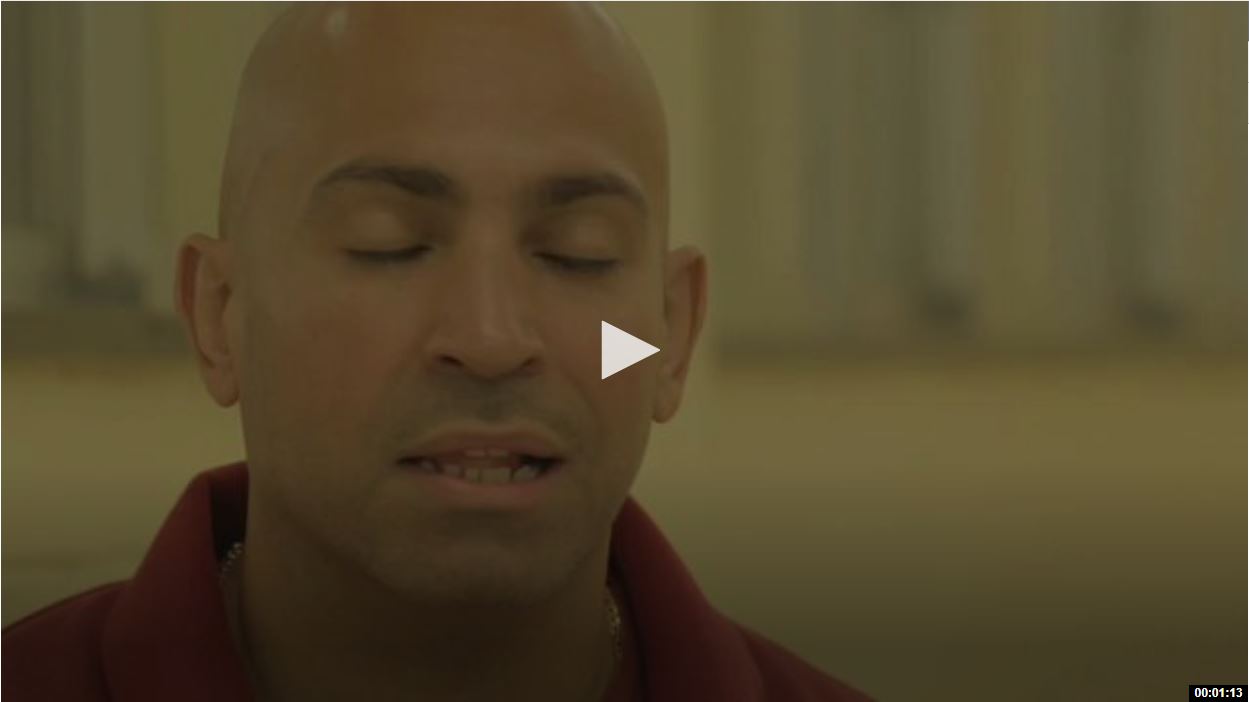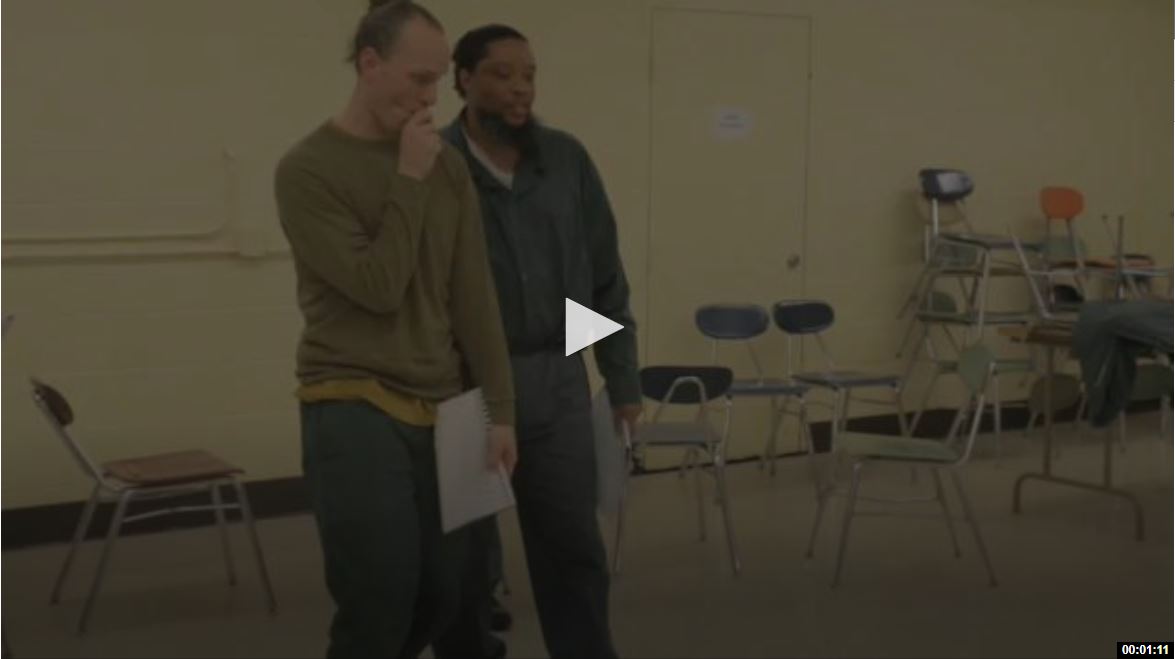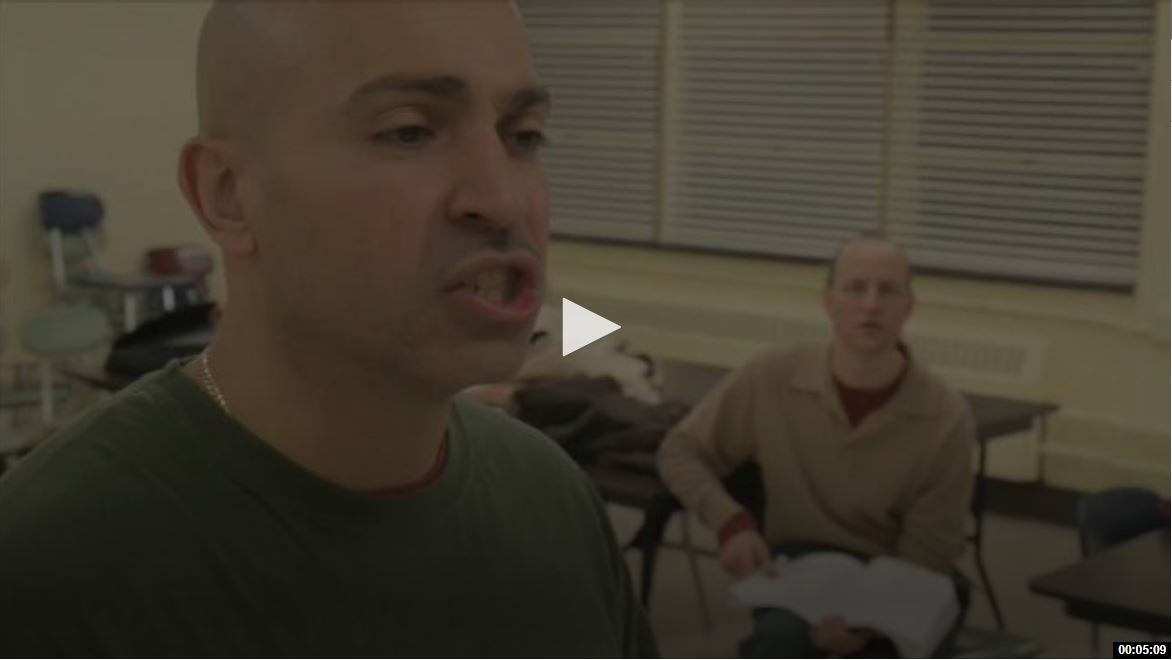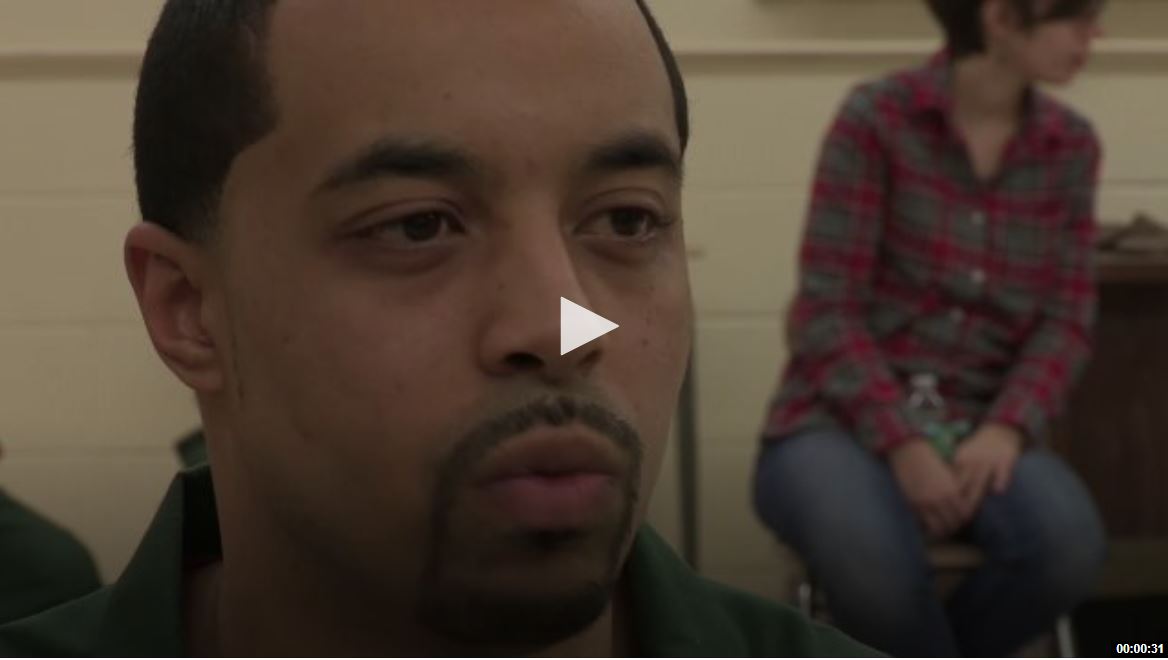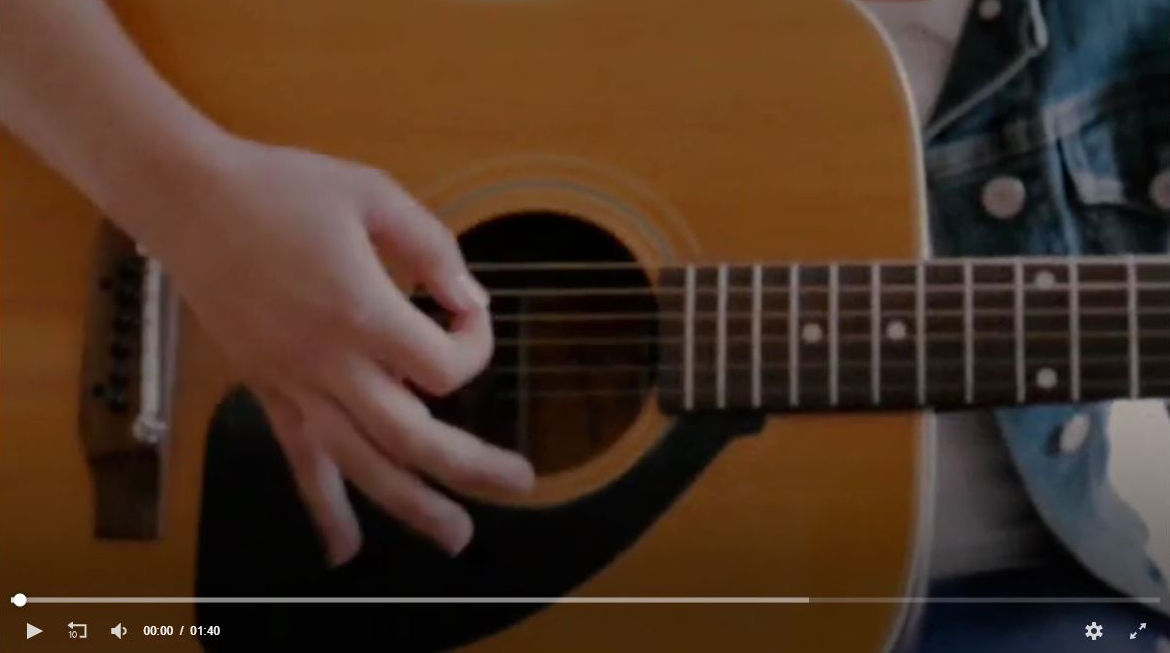Abstract
This group reflection by the Phoenix Players Theatre Group focuses on the power of making theatre in prison in relation to issues of futurity: freedom, optimism, opportunity, hope, and their darker counterparts. Notions of the future evoke feelings of success and fulfillment, as well as more tragic effects like frustration, stagnation, and depression. The perspectives of incarcerated people navigate both the hope of the future, as well as the possibility of that hope’s falsehood. Rather than articulate any single, overarching argument—which risks flattening differences of opinion, a rhetorical mode that has, historically, de-privileged the experiences of marginalized people—this article embraces multiplicity, complexity, indecision, contradiction, and paradox. Some of these reflections take the form of interview transcriptions or, indeed, theatre scripts, as the Phoenix Players voice their thoughts and feelings living in and with mass incarceration. In addition, these dialogues are punctuated with video clips and individually authored creative interludes reprinted here from past performances.
Introduction
The Phoenix Players Theatre Group (PPTG) is a performance collective located in the Auburn Correctional Facility, a maximum-security prison in upstate New York. The group was founded by Michael Rhynes and Clifford Williamson, men incarcerated in the Auburn Correctional Facility. In the words of the group’s founders, “[PPTG] is a transformative theatre community, which utilizes theatre to reconnect incarcerated people to their full humanity.” Even though the group invites several civilian facilitators into its meetings, PPTG is run and operated by incarcerated people. Since 2009, PPTG has held small, tight-knit workshops for two hours each Friday evening, with the aim of creating a space where imprisoned writers and performers can be witnessed, and where they can initiate a process of personal, cultural, and sociopolitical transformation.

Figure 1: Founding PPTG members Kenneth Brown, Michael Rhynes, and Shane Hale, along with first volunteer facilitator Stephen Cole and former head of volunteer services Dave Roth, discuss the origins of the group.
Courtesy of the Phoenix Players Theatre Group.
At the opening and closing of each session, the group recites its motto:
We are a community of transformation
Through the power of self-discovery
We create the opportunity
To know and grow into ourselves.
To fulfill this mission, the members participate in a training process, craft theatre pieces, rehearse scenes and monologues, discuss current events, and share personal stories. Ultimately, the group devises a 90-minute performance, mostly composed of solo pieces sutured together into a kind of theatrical collage, to be presented every 18 months to 2 years before an invited public audience.
According to Rhynes, the symbol of the rising phoenix represents incarcerated persons and community reborn to their humanity. He says that “[theatre] is the conduit we use to reach the still waters of the soul” (Rhynes 2014). He selected the phoenix because it represents transformation—as opposed to rehabilitation. To Rhynes, the concept of rehabilitation entails other people having control over the lives of prisoners. In contrast, he believes that transformation is about taking control of one’s own life in one’s own hands. Rhynes feels that PPTG should be about more than the mere rehabilitation of some inmates. He writes, “PPTG is about the transcendence of our past lives” (Rhynes 2014). To explore these and other facets of the PPTG process, this group-authored paper takes the form of a performance dialogue, incorporating the creative writings and personal reflections of the incarcerated members of the prison theatre group.
The embedded video links also serve as background insights into the group’s founding and its work. Most were recorded with the original founding members in 2012, during the filming of the feature-length documentary about the group, Human Again, less than three years after the group’s origination. Members were interviewed as they prepared to present their second devised piece, Maximum Will—a presentation that interwove soliloquies from Shakespeare with reflective, autobiographical pieces written by the Phoenix Players themselves. The film introduces the incarcerated members of PPTG by using their mug shots—one of the most publicly recognizable images associated with the incarcerated. This technique was employed to contrast the stereotypical image with the reality of their full humanity.
This article focuses on the power of making theatre in PPTG in relation to issues of futurity: freedom, optimism, opportunity, hope, and their darker counterparts. Notions of the future evoke feelings of success and fulfillment, as well as more tragic effects like frustration, stagnation, and depression. The perspectives of incarcerated people navigate both the hope of the future, as well as the possibility of that hope’s falsehood. By involving multiple voices in a single text, we create a dialectical space in which these differing perspectives are placed in conversation with each other. This format emphasizes the intersubjective, communal aspects of theatre in order to create a textual “stage” for expression. Rather than articulate any single, overarching argument—which risks flattening differences of opinion, a rhetorical mode that has, historically, de-privileged the experiences of marginalized people—this article embraces multiplicity, complexity, indecision, contradiction, and paradox.
Recalling Paulo Freire, this tension therefore characterizes a praxis of “critical hope,” a future-oriented attitude that nevertheless grapples with the challenges and despairs of the present. For Freire, the elimination of hope is one of the central functions of the mechanization and bureaucratization of global capitalism (Freire 1998). The rise and saturation of carcerality today exemplifies, in violent, dramatic fashion, the destruction of hope in the neoliberal machine.1 Freire believed that it was in critical reflection and dialogical engagement that the utopian desires of hope might be realized (Freire 1970). The founders of PPTG cite Freire as an influence in their work, specifically in their use of self-reflection to seek self-liberation. The writings of theatre theorist and practitioner Augusto Boal are another inspiration for the group, in this regard. Building on Freire, Boal sought to turn participants into “spect-actors,” who would not only serve as critical witnesses to situations of oppression and injustice but would also take control in these situations actively (Boal 1993, 1995). Those who follow his notion of theatre embrace a dialectical praxis that spect-actors can carry on in their lives outside the theatre. We foreground in this article the statements of the members of PPTG that practice critical hope, in order to explore how those living in conditions of confinement struggle in the present as they look to the future. As prison theatre scholar and practitioner Michael Balfour asserts, “Theatre can redirect gazes, shift perceptions and change the display. It can debate the serious pain in the system” (2004, 74). This redirected “gaze” opens a window to critical hope for the men of PPTG, as they participate in and direct the group.
Some of these reflections take the form of interview transcriptions or, indeed, theatre scripts, as the members of PPTG voice their thoughts and feelings on the present and future living in and with mass incarceration. These dialogues respond to five formal questions posed to the group, from “What does freedom mean to you?” to “When did you most lack hope, optimism, and/or freedom?” At the time of this writing, PPTG comprised eight incarcerated members living in Auburn Correctional, all of whom participated in the exercise: Nate Powell, Demetrius “Meat” Molina, Adam Roberts, Sheldon “Superb” Johnson, Raymond Van Clief, Mark “AZ” Thompson, Jerome Walker, and Robert “Bam” Lawrence. Prisoners in Auburn Correctional live in individual cells, as opposed to dormitory-living or sharing a cell with a bunkmate, and because of this separation between members, crafting these dialogues posed an interesting challenge. It would be difficult to simply gather in one open location and record a group conversation. Instead, the prompts were written out and passed between members of the group, who wrote their response on their own before giving the sheet of paper on to the next man. At the end of the process, the reflections were gathered and edited together. This writing itself therefore constitutes a kind of performative crossing of boundaries. By employing the communal perspective of performance, the members of PPTG create both physical and discursive space for imagining and shaping the horizons of (un)freedom.
In addition, these dialogues are punctuated with video clips and individually authored creative interludes reprinted here from past PPTG performances. We organized the writings in this article into sections, which help structure the insights offered by the group into discrete themes that are nevertheless linked: Freedom, Optimism, Opportunity, Hope, and Darkness. In aggregate, these themes offer readers a view from behind prison walls of the horizons of (un)freedom. The potential freedom of the future is held in sight alongside the risk of liberation’s failure to arrive.
In the wake of the 2014 shooting of Michael Brown in Ferguson, Missouri, the protest poem “Civil Disobedience” offers a powerful statement of solidarity with those on the outside organizing against police killing of unarmed black men. The poem “A Tear Gone AWOL” further considers the category of struggle in the context of mass incarceration, abstracting the moment a tear falls to capture a broader picture of self-reliance and strength. The meditative “Words Make Your World” considers language’s reality-shaping capacity, making a powerful argument for speaking the truth. “Looking Good” engages the interlocking issues of addiction and families of incarcerated people, offering a glimpse of how the ghosts of the past haunt the lives of prisoners in the present. In “Window onto Pain,” a memory of a game of chess between father and daughter assumes heartbreaking significance. Memory is also explored in “Not Answered,” a plaintive meditation on the troubled relations between mother and son in the context of life imprisonment—a sentence all-too-common today. In the remorseful “Mirror Reflections,” the speaker examines himself, trying to understand the aspects of his environment and personal history that created the conditions for his choices that led to his conviction and incarceration. Finally, the percussive poetry of “Story of Words” paints a picture of the nanoseconds just before arrest and imprisonment.
We also include two creative pieces written by members of PPTG who no longer reside at the prison in Auburn. Because members of the group have been released or moved to other prisons in New York State, the composition of the group has always been in flux. But the spirit and contributions of past PPTG members persist—a fact this writing reflects. We include here cofounder Michael Rhynes’s satirical monologue “Zoo,” which posits (with no small amount of irony) that modern zoos model themselves on the racist structure of the prison. The memory piece “Fourth of July Fireworks” by Efraim Diaz demonstrates how recollecting hopeful moments from the past—in this case the birth of a child—can sustain the prisoner in the present. Additionally, two non-incarcerated volunteers participated in writing the introduction and conclusion, and in editing the other sections: Nick Fesette and Bruce Levitt.
In different ways, these writings show that the members of PPTG participate in a praxis of critical hope. They are engaged in a contradictory dialogue with the future, hoping with utopian verve while at the same time reflecting critically on the realities of their past and present. As Balfour argues, theatre is especially suited to explore the contradictions of socially engaged practice that is, on the one hand, resistant to the violence of the prison, and yet, on the other hand, encased in its overarching rehabilitative and penal structures (Balfour 2004, 2–3). However, in resisting attributing a rehabilitative mission to its practice, PPTG employs critical hope that is both more elusive and more transformative—in regards to both the individual and the community. In the short conclusion to this article, we expand on some of the themes and insights explored throughout, as well as connect this practice to larger struggles against mass incarceration. Inasmuch as it is approached as a transformative praxis of critical hope, rather than as a rehabilitative program, it is our belief that prison theatre—like prison art in general—can constitute the type of “non-reformist reform” called for by prison abolitionists Dan Berger, Mariam Kaba, and David Stein (Stein 2017).
As a group, the authors reflect on the negotiation of the potentialities of the future. This negotiation is both innervating and enervating, vivifying and vexing. By foregrounding the necessarily unresolved nature of this conversation in the mode of drama, PPTG sparks further dialogue on the social, structural, historical, embodied, personal, and affective issues of the futurity of incarcerated people.
Notes
1 Neoliberal politics can be understood as a general regime of extreme austerity: the simultaneous shrinking of the Keynesian welfare state and the decentralization and privatization of public goods and services. Paradoxically, what has occurred as the state has on the surface attempted to dramatically cut its spending, is that an astonishing amount of government resources have been funneled into the military, police, and prison. See Gottschalk 2015. For more on the struggle of critical hope within this ideology, particularly in the context of UK higher education, see Sutton 2015.
Freedom
Figure 2: Founder Michael Rhynes discusses issues surrounding prison “rehabilitation” and what makes PPTG unique.
Courtesy of the Phoenix Players Theatre Group.
“Zoo”
by Michael Rhynes
What came first—penitentiary tours or zoos? The first penitentiary tour was conducted at Walnut St. Jail in 1790. The first zoo in America opened in Philadelphia in 1874. So zoos were established 84 years after the first penitentiary tour.
A penitentiary tour consists of members of the public walking through prison observing humans in their un-natural habitat. Oh! How they try to conceal the stench of human incarceration with somber faces.
I am from the North side of Rochester, NY; it’s two miles from my neighborhood to the Seneca Park Zoo. One day my friends and I grab our homegrown bikes (homegrown bikes are pieces of thrown away bike parts, a sprocket here, and a raggedy banana seat there) and we pedaled the two miles.
When we get there the grass is beautifully manicured, the trees are well groomed, I could only stare in awe. Damn, this looks better than our neighborhood! As we rode deeper into the interior we saw kids enclosed by a fence swimming in a pool. Damn! This pool is better than what the city lets us swim in.
The first animal I encountered was a Llama. He strutted up to the woman standing in front of its cage and spit in her face: I wondered why he would do that? The zoo people had rescued him and were feeding him at least three times a day.
The next animal I encountered was a Monkey. The only thing I knew about monkeys came from reading Curious George. This monkey had no smiles for me; he looked at me with angry eyes. Then he turned his back to me; looking over his shoulder he intentionally scratched his ass: Curious George would have never disrespected me in such a manner. That monkey should be grateful he's getting free bananas and he has a jungle gym.
Riding up to the next cage I saw an Ostrich, and I was amazed it didn't have its head in the sand. It pranced up to the cage and gave me the once over. The look made me feel dirty and ashamed for coming to the zoo: Why would this animal do that? As a human I have a right to invade its privacy, and taxpayers are paying for its food and keep.
The next animal I encountered was a Giraffe eating leaves from a tree. It glanced at me from the corner of its eye. It walked over and looked down at me as if I were familiar, but I've never been on the Serengeti Plain. Then it peered at me like a disappointed professor wearing glasses. I was perplexed. The Giraffe had trees and no lions to hunt it. Shouldn’t it have been grateful for being rescued?
One hundred and ninety-seven years later—from 1790 to 1987—is when I experienced my first prison tour. Sitting in the cell reading a book, and down the gallery walk these people. I was surprised and shocked as they were. After I got over my shock, I had this uncontrollable urge to turn my back and look over my shoulder and scratch my ass.
It suddenly dawned on me why I never visited another zoo. I finally understood what those animals were trying to say.
Figure 3: Founding member David Bendezu reflects on his life before incarceration.
Courtesy of the Phoenix Players Theatre Group.
As a prisoner, what does freedom mean to you?
Nate: Camus said, “The only way to deal with an unfree world is to become so absolutely free that your very existence is an act of rebellion.” Michael Rhynes not only embodied this absolute freedom, he found a way to harness his existential energy so as to transform others! What an amazing gift. Thank you, Michael.
AZ: To make sound choices that have a positive impact on the lives of others who are less fortunate than me. PPTG has allowed me to express this freedom internally each and every day.
Adam: Freedom means the space to make inner decisions to respond to the outer world. Our constructive play in PPTG every Friday night allows me to feel more free than I did at times before coming to prison.
Meat: Freedom to me is the ability to use my mistakes as a foundation for change. Freedom is where I find peace. They say mistakes bring experience, and experience brings knowledge; I feel the most at peace within myself when I’m able to use the knowledge I’ve gained to help others make better choices in life. PPTG has allowed me to find that peace.
Ray: Yo when did we end up in prison? I thought we was at [the volunteers’] house every Friday. I need to reflect on optimism to gain some freedom.
Walker: Not taking the miracle of life for granted and remembering how extraordinary my ordinary life truly is.
Bam: A second chance to get it right. Taking advantage of all the little things I took for granted.
Superb: To have my thoughts unintruded by societal boundaries and be who my heart desires absent cultural restrictions and religious tradition. Performance has provided me the freedom to create my own reality and cross burnt bridges.
“Civil Disobedience”
by Sheldon “Superb” Johnson
Hands up, don’t shoot!
Hands up, don’t shoot!
I shouted at the approaching
Rookie recruit
In his pressed blue suit
In obvious pursuit
Of fame and infamy!
“Hello, 911?”
“Yeah, I’d like to report a crime.”
This savage just utilized his glock
A military grade plastic stock
In murderous symphony
An unholy matrimony
Ended absent alimony.
Hands up, don’t shoot!
Hands up . . .
Don’t HATE the beauty of my SKIN.
Although you may believe
HAM was cursed through
The magnificence of my SKIN.
A hereditary dossier of rebellion
Passed via the DNA of my KIN.
Hung and enslaved
By the blood of your KIN.
Was not 1964 supposed to be
The linchpin
To your lynchin’?
Mason Dixon line pimpin’?
I guess it’s Black Friday
In Ferguson.
Hands up, don’t shoot!
Hands up, don’t . . .
Infest my community with CRACK!
Nor dispatch your maniac
White coat quack
With project Tuskegee syphilis
Masqueraded as an aphrodisiac . . .
Placebos and cardiac arrests.
Then get upset when I attest
Annihilation:
At the end of your gavel!
Black robes, black scams,
Black books that bind
The black mind:
In rusty fecal chains!
All in the name of:
Capital rich cotton pickin’ gains!
Yet, the only truth that remains
Are the ashen broken bones of
Antiquated remains.
Hey y’all . . .
It’s Black Friday in Ferguson
Civil unrest is the reason
To murder in the face of INNOCENCE
Is statutory TREASON!
A conclusion not an illusion
That it’s open season.
Hands up, don’t shoot!
My hands were up,
Why’d you shoot?
Optimism
“Words Make Your World”
by Jerome Walker
Words can position our self-image and condition our minds for unhealthy states of existence.
When was the last time someone asked you, “How are you?” and you said, “Fine,” even though you felt horrible? That’s common for most of us. It is a programmed response. But it’s deeper than how we respond to small talk. We really do brush over our mixed feelings with a patina of ambivalence and nonchalance. Simply put, we act like stuff isn’t fazing us. Of course, some of us are emotional basket cases, but that’s a disorder that needs years of therapy. On the other hand, our inability to talk about our problems is something we can fix. First, we need to admit when something is wrong. Second, we need to be able to identify which parts of that problem we are responsible for. Those are the parts we can change. We can only change how we feel about the rest of it. If we would be authentic, then we would stop being fake to be accepted. And if we could tell our children what is really going on in the world, they might actually be prepared for it.
How often do you tell the truth about how things really are?
How do you strengthen your optimism?
Nate: PPTG is a human circle which frees you to be yourself. PPTG may have been founded by convicts, but it began as a hazy dream which required the combined imagining of insiders and outsiders, theater vision and harsh experience, book smarts and street smarts, intuition and discipline. It is this powerful human amalgam which worked to reimagine the space behind the walls of Auburn Prison. This reimagined space is the freest place I have ever been in my life! This human space urges us to reimagine who we are and who we may become.
Superb: Sadly, by reflecting on others’ tragedies, allowing me to recognize the beauties that exist and that transformation is attainable.
AZ: By trusting in the process of transformation, and knowing that our mentors are alongside me every step of the way, I no longer feel alone in the world.
Ray: A lot of my strength comes from the effect it has on those around me. Why should a glass be half empty? When we all can drink from a glass half full!!!
Bam: Doing right and taking advantage of opportunity. Knowing I’m not alone and having a “community” that supports and believes in me.
Walker: By counting my blessings, so I can pay attention to all of the good things in my life.
Meat: By understanding that no matter how difficult things may become for me, there is always someone out there whose life is harder. I try not to dwell on the things missing from my life, but instead give thanks for all my blessings. This keeps my mind strong and my energy positive.
“A Tear Gone AWOL”
by Raymond Van Clief
Forever has my valor been questioned.
I’m a dismissed idea, broken and underdeveloped,
The true idle play between departure and reanimation,
A type of haze that clouds the judgment of a weary face,
And so I cling to the weight that becomes too much to bear.
Imagine an anvil chiseled from the cynical remains of an unapologetic truth.
From there the water pools . . .
Slowly descending towards my mouth,
Etched in a river of sorrow,
Where the salt-like flavor leaves a bitter taste,
A sojourn to heartbreak
With an eruption so strong it makes the soul quake.
And so this is where I cascade . . .
I have been placed in this moment where I fell from.
There was nowhere to go, so I continued to run,
Never afforded a brand of loyalty till I created some,
Still a false sense of security when there is none,
An unexpected memory is my nemesis when it comes,
So I take the painful road march—to savor the freedom.
Opportunity
Figure 4: Founding member Efraim Diaz talks about the hardest parts of living in prison, and shares his reasons for joining PPTG.
Courtesy of the Phoenix Players Theatre Group.
“Fourth of July Fireworks”
by Efraim Diaz
It was July 3, 1989. Every year on the 4th of July we have a big family gathering. This year we were to celebrate Independence Day at South Beach.
We spent the day shopping for everything we needed for our big family picnic.
We bought steaks, chicken, fish, beef, burgers, beer, and plenty of fireworks. The family was really excited cause we were going to meet family members we hadn’t seen in many years.
Late that night about 11 p.m., I received a call from Mary. She said that Estelle was in the hospital. I called my parents and told them I was headed to Lutheran Medical Center. Once I arrived at the hospital I met Mary, and Estelle’s sisters and brothers. I asked how long she had been there. One of her sisters said since about 10 p.m. The doctors came out and asked me if I was ready. They suited me up and we proceeded to the delivery room. There she was lying in a bed having contractions. To be honest with you, she didn’t want me there because I was being blamed for being the cause of her pregnancy . . .
The time arrived and she pushed, and the yelling and screaming got louder and louder. But something happened. The baby turned, and they had to perform an emergency C-Section. I had to leave the room and spend the rest of the night in the waiting area.
It was now about 3 a.m. When the doctor finally came out and said, “congratulations, you’re a daddy to a healthy baby girl,” I was so excited I didn’t know how to act. My emotions were all over the place because it doesn’t matter how prepared you believe you are, when you are struck with such a life-changing experience you feel like you don’t know what to do.
As I left the hospital I stopped at the 24-hour gift shop and bought 2 boxes of cigars. ”It’s a girl.” I was giving them out to whoever I knew and those I didn’t know. Rather than calling, I went to my parent’s house to let them know they were grandparents. They sat me down and gave me a lecture on parenting . . .
That morning I decided instead of going on the family picnic I would spend the day at the hospital with my baby girl—the new part of me.
That evening, after visiting hours were over, I was able to stay a lot longer because parents’ visiting hours are extended. I was able to really take in the moment and speak to Melanie.
We had a room facing the river and from a distance we were able to see the Macy’s 4th of July fireworks display. Then it hit me—I was overwhelmed with emotions I’ve never experienced.
I stood there looking out a soundproof window, staring at my image holding this priceless gift, sharing my first 4th of July, just me and Melanie, enjoying the Macy’s fireworks with this new part of me.
So every Independence Day for the remainder of my life I will always remember this life-changing experience. I always cherish and love the 4th of July.
That’s my story.
What opportunities are present in your life?
AZ: PPTG has become the greatest opportunity in my life. At 61 years of age I’m still learning to grow into myself.
Adam: AZ makes a great point. The latter half of our motto is “We create the opportunity to know and grow into ourselves.” What can be a better opportunity than the chance to become your best self?
Ray: The best opportunities are those that exemplify community. Coming together to lift one another up, to see and become our best selves.
Bam: “Transformation” is one of the opportunities I am most proud of. PPTG embodies this concept, thus allowing me as well as others to “grow into ourselves.”
Nate: PPTG is literally an experience which changes you—for the better! The American justice system does not provide a way for criminals to atone. Punishment is the focus, hinging on hatred, which is directly attached to structural racism. PPTG helps us heal. The first step in healing is to recognize the mistakes we have made and the harm we have caused.
Walker: Given the opportunity to work on myself and get better at being me as a member of PPTG is an awesome experience.
Superb: The opportunity to make a difference is ever-present, my attitude, my choices, the words that I choose to describe my condition determine how I will embrace and shape the world, the opportunities for love, wisdom, and understanding.
Meat: To live, to love, to show remorse, to think, to change, to grow, to help, to share, to teach, and to hope.
“Looking Good”
by Adam Roberts
This past August, my brother came to visit me; it was one of the facility’s summer picnics, a very nice affair that takes place in a grass courtyard, hemmed in by the school building and the prison’s large gray wall. He’s three years younger than me, and just a really simpatico person, easy to be around.
My brother is married, with children, so our visits these days happen once a year, the summer seems to work best, though we both wish it could be more often. I make sure to have pictures taken, partly for me, but also as a way of keeping me visible to the rest of the family, who don’t make the five-hour drive to visit. As it happened, my brother was at our uncle’s house the day after our visit, so he shared the picture, along with a debriefing—knowing my brother, it was a most perfunctory recounting, something along the lines of Yeah, no, he’s good.
This resulted in my uncle sending me a letter, which ended with “You look good. I expected nothing less.” Something about it made me think that this was more than a throwaway line, that there was more to it. Not long after that, I received a birthday card from my other uncle, in which he, too, said “You look good.” Although, his was in reference to my performing Snow White in a PPTG video clip he found online.
So are we a superficial family, concerned only with how one looks while he’s doing 25 to life?
To understand their comments, you have to know the truth about me, know what my family knows. They know that a duck can appear to be floating placidly, but under the water’s surface he paddles like mad. In the late 1990s, I also looked good, but on closer inspection, my long sleeves were worn to cover up track marks. The dark circles around my eyes were from something else besides poor sleep. Baggy clothes hid just how skinny I’d become.
When I’d make repeated, long trips to the bathroom, what did they imagine I was doing? Surely it was not me on the floor cooking heroin in a spoon, tying off, and shooting up. Nor did they imagine me tiptoeing around the house, finding my way into private spaces, sheistily stealing money like the Grinch.
Leaving family gatherings on the thinnest of pretexts, to speed into the city to cop. They know that it led to something much, much worse than the draining of bank accounts, the loss of jobs and friends. It led to a family tragedy. That’ll be 17 years ago this November. But the truth is the truth—17 years ago, or 17 minutes.
Do they see what you see, someone who is adequately composed and intelligent sounding? Yes, but they notice more what is absent: frantic requests for money, unexplained trips to the bathroom during visits, and the preposterous lies. And, I imagine, that in my participation in the Phoenix, they see someone who spends his Friday nights in theater nerdery, a positive activity, not copping dope.
The truth about me is that I’m sober, no longer letting my self-destructive urges call the shots. I am someone who has taken the heavy weight of his past, and used it as a cantilever on a bridge to a better place. That’s what’s hidden in the comments of my family. When they say I look good, what I hear is that I’m doing good. And that’s what matters to me these days.
Hope
Figure 5: Kenneth Brown discusses how he came to join the group and shares his thoughts on acting, in between rehearsing for PPTG’s performance of Maximum Will, an original piece adapted from the works of Shakespeare.
Courtesy of the Phoenix Players Theatre Group.
“Not Answered”
by Mark “AZ” Thompson
Mamma, it’s been nearly a decade
Since I’ve last seen your smiling face.
Mired in pain and frustration
I can’t begin to relate:
Not one, but two
Sons in the belly of the beast,
Cast off somewhere upstate.
Do you remember the time and place?
Attica . . . May 16th, 1992
As I stood with my cap and gown
I was proud as hell;
Yet, it was hard to tell.
I’m no longer the young man
You once knew.
Years of confusion and mistrust
Have driven me nearly insane.
Lots have been cast . . .
My name has been drawn . . .
Here I sit with the criminally insane.
Murderers, rapists, drug sales gone bad . . .
It’s sink or swim
For those who won’t change.
Mamma, tell me why there’s a tear in your eye?
Does that explain why you haven’t struggled
To keep me alive?
This most recent journey
Has given me time to reflect.
Travelling six days
Bound and shackled to my ancestral brother
Leaves little doubt
Why the townsfolk of Malone
Look upon us as mere chattel property.
Present in the here and now
To fill their depleted coffers
As their great benefactor cries out:
“Vote me in, I’ll save the day.
I promise that a Special Housing Unit will be
Coming your way.”
I’m tired of all this
Tough on crime shit.
Lock ’em up and throw away the key won’t mix.
When most of these cats are released
It’s not me, but you that they’ll want to get.
Their hopes and dreams have been stripped
Less education, no new programs
Meaner guards
More time spent in prison yards.
Not fully realizing where they really are
Caught in hell’s kitchen
Merely another ingredient
Added to the grand scheme of things.
Mamma, tell me why there’s a tear in your eye?
Does that explain why you haven’t struggled
To keep me alive?
The new millennium is here
And I question what awaits
The future of my grandson Sha.
His young mother
Has witnessed first hand
Loneliness, pain and despair.
She lost her mother to HIV
While her father writes from his cell.
Once every few years a letter appears.
“The kids are well, your dad is fine,”
I merely ask myself:
“Where has the time gone?”
I’ve spent the last 39 years
Locked behind iron gates
Seeking to find meaning to my existence.
Was it a mistake?
Should I have been aborted?
Or flushed before millions of sperm
Fought to bring me to this ungodly place?
All it took was one.
Me . . . 62 years old
Serving life
Not living out life.
Mamma, tell me why there’s a tear in your eye?
Does that explain why you haven’t struggled
To keep me alive?
What gives you hope?
Adam: Emily Dickinson wrote that “Hope is the thing with feathers.” The Phoenix, PPTG’s namesake, has feathers, too, and soaring out of one’s cage is a hope-creating endeavor.
Superb: Purpose, the power of self-discovery, the opportunity to know and grow into myself; family, community, the goodness I believe is inherent in all people.
AZ: My PPTG family. No one has ever believed in me and every Friday evening my PPTG brothers and sisters encourage me to share with them the person God created me to be.
Ray: Hope is that empty incomprehensible feeling you might have, yet energy output to create something from nothing. To believe is to create. By believing in our PPTG family we extend hope to each other.
Bam: The person I have become regardless of the road I had to travel. PPTG is an example of “the light after the darkness.”
Meat: My children are the reason my failures give me hope. My life once traveled on a path of destruction, with tragedy being the first destination. After such pain and such loss, change was necessary and so I chose a different route. For my children, I sought out transformation, found a community of it, and discovered a better me. Respect, Integrity, Positive Leadership, Morale, all qualities that reflect the man I’ve become. I am far from perfect and still make mistakes today. However, each day I am striving to be better than I was yesterday, and through my failures, I am able to teach my children not to make the same mistakes I’ve made. That is my hope.
Walker: Doing something each day that adds value to my life and the lives of others.
Nate: There was a vicious, hateful guard glaring at one of our performances. He looked like he could pull duty at any of the infamous stalags. When he watched us live our stories, real tears streamed down his cheeks! Never underestimate the power of truth and compassion. Let us reimagine a new narrative, together!
“Window onto Pain”
by Nate Powell
My daughter was four years old when I got locked up. For the next two years, while I fought my case in court, she could only visit me across a stainless-steel table that was wider than she was tall. Visits were less than an hour.
Once a week for a few moments I could see the little girl who was suffering because of something I did. There were no games allowed. That table was always cold.
After sentencing I was able to visit with my daughter for more human lengths of time in a venue where hugs were monitored, but O.K., and where we could play games. When my daughter grabbed a chess set, I remembered when she first asked me to teach her how to play. We were in Washington Square Park and this old Russian guy with medals and epaulettes was playing a young black guy with dreads. The intensity of their game mesmerized her. She said, “Daddy I want to play that game.”
I was teaching her how to play chess before I got locked up. My wife told me she hadn’t played since. So when she set up the pieces in all their proper places, I was a little surprised. “When is the last time you played?” I asked her. “With you,” she replied. Then she confidently moved her knight out and smiled up at me.
She pushed her pawns, edged her bishop into position, and castled. She clapped her hands when she took my knight with her queen. She didn’t forget a single solitary thing! She said, “Why are you crying Daddy?” All I could do was smile.
I never knew there could be so much pain.
Darkness
Figure 6: Efraim Diaz, Dave Roth, Michael Rhynes, and Shane Hale talk about the difficulties of prison life.
Courtesy of the Phoenix Players Theatre Group.
“Mirror Reflections”
by Robert “Bam” Lawrence
From as early as I could remember, you have always been a problem child. School was not important back then, you had the world figured out. Making classmates laugh gave you this tremendous sense of power. Thereafter, you discovered following direction from adult figures contradicted the newfound power that was defining who you were. Distracted, you gradually allowed your behavior to become riskier, a decision was made to drop out of school—and what followed was you being heavily influenced by the wrong crowd, older individuals setting the bar and allowing you to follow their lead. Sadly, crime soon became a way of life. First was strong-armed robbery, which led to an arrest and probation. Still not having a healthy respect for a society of laws, you turned to drug dealing. Selling drugs led you to more than 300 miles away from home. A drug deal gone bad, and unfortunately someone lost their precious life. Many changes have taken place since those adolescent days, significant transformation can now be added to the discussion surrounding the individual you have become. Moving forward while never forgetting your past, keeps you grounded, which, in turn, humbles you in a way that allows you to continue to aspire to one day become a productive member of our society. Prison, for you, has mostly consisted of growth and development, no doubt there were trials and tribulations along the way. Fortunately, you have never succumbed to the darker side of this existence. Yeah—that existence definitely exists! Twenty-seven years later, and I still remember every moment as if it were yesterday!
When did you most lack hope, optimism, opportunity, and/or freedom? What was going on in your life at the time?
Adam: Shortly after I arrived at Auburn in 2014, my grandma died and I was denied conjugal visits with my wife. It was a very dark time for me. Several months later, I accepted Michael Rhynes’s and Meat’s invitations to join PPTG, which was just what I needed.
Nate: Efraim Diaz tagged me in to PPTG. I never thought of theater as transformative but I witnessed a huge change in Diaz. He had been fighting his legal case and was bogged down in the quagmire of jurisprudence, a language so alienating that identical words can mean different results. Diaz shook his head when he showed me those cases, but after PPTG he had newfound hope. Diaz positively glowed and was just more fully alive, more compassionate, more aware. He said I had to try it, so I did. PPTG was one of the best gifts I ever received. Thank you, “D.”
Ray: My lack of hope came to me shortly after my crime. I realize the disappointment to myself and loved ones. It remains my darkest moment, yet I have found a new light through PPTG. They are my support anchor.
Bam: When it became clear that I actually would die in prison as a result of the crime I committed. I was a reckless juvenile who thought he had the world figured out. Thankfully, I no longer have to spend the rest of my life in prison, but the damage has been done!
Walker: Coming to prison at the age that I did and facing the time that I am facing. PPTG is a therapeutic outlet I am fortunate to be a part of.
Meat: When I was “knee deep” in the lifestyle that led me to prison.
Superb: When I was thuggin’ and buggin’, when I was drinkin’ and druggin’, when I was consumed by the streets, I had a distorted perception of hope, optimism, opportunity, and freedom because my thoughts and subsequent decisions were clouded by ignorance.
Figure 7: Demetrius “Meat” Molina talks about the challenge and pleasure of sharing personal thoughts and feelings in the safe space shared by PPTG weekly.
Courtesy of the Phoenix Players Theatre Group.
“Story of Words”
by Demetrius “Meat” Molina
Showering drying dressing leaving.
Driving arriving walking standing waiting.
Paying entering ordering drinking talking dancing drinking.
Buzzing laughing partying slurring drinking drinking.
Sensing seeing tensing grouping watching.
Waiting closing leaving avoiding warning yelling raging.
Pushing pushing swinging fighting.
Pulling aiming shooting screaming running shooting driving speeding hiding.
Waiting hearing fearing disbelieving.
Thinking regretting stressing blaming running hiding fearing.
Crying praying pleading hoping.
Packing leaving driving.
Stopped caught cuffed arrested.
Figure 8: The trailer for the feature-length documentary about PPTG, Human Again.
Courtesy of the Phoenix Players Theatre Group.
Conclusion
How does prison theatre engage with the current historical and political reality of mass incarceration? In one obvious sense, theatre can empower incarcerated people to share their own stories—as the members of PPTG do in this article. Partly because of the rise of mass incarceration, we find ourselves today saturated with prison narratives. As Doran Larson argues in the introduction to his prison writing collection Fourth City, researchers study this literature with the assumption that solutions to the problems of the criminal justice system can be found within works by writers who have experienced imprisonment (2013). PPTG offers theatre as another way to support the voices of incarcerated people, in keeping with Freire’s famous dictum: “One cannot expect positive results from an educational or political action program which fails to respect the particular view of the world held by the people. Such a program constitutes cultural invasion, good intentions notwithstanding” (1970, 95). Theatre can literally place center stage the real voices and experiences of incarcerated people for public engagement, so that their stories can spread and complicate the often-sensationalized depiction of prison life.
Further, in his writing on prison theatre in the UK, Baz Kershaw (2004) suggests that finding and practicing theatre within the prison setting is a radically resistant and even transgressive act. Kershaw theorizes “freedoms of oppression,” in which performance “can significantly contribute to the collective and individual creation of autonomous subjects, especially through an engagement with systems of formalized power in an effort to create radical freedom” (136). This paradoxical freedom recalls the writings on oppression by Freire and Boal. For Kershaw, the oppressed subject who creates theatre reckons with the overwhelming power of the institution and thereby uncovers the potential for radical political action. Indeed, the space for creative freedom finds itself precisely because it is encased within a space of exclusion and confinement; freedom and oppression are co-constitutive in Kershaw’s model. Rather than view this reductively or pessimistically as the co-optation of the freedom of theatre practice, Kershaw suggests the opposite: it is oppression which is co-opted by the transgression and transcendence of theatre making.
To delve into just one example, the “Freedom” section of this article starts with PPTG founder Michael Rhynes’s personal recollection of a zoo he visited as a youth. The monologue compares the living conditions of the animals he saw to his own as an incarcerated adult. In doing so, Rhynes parrots the arrogance and indignity to which prisoners are subject when non-incarcerated people visit the prison on tour. In performance, Rhynes molded his body to fit the characteristics of the animals he describes, miming their movements and rhythms. This piece echoes an observation made by abolitionist Angela Davis: “Jails and prisons are designed to break human beings, to convert the population into specimens in a zoo—obedient to our keepers, but dangerous to each other” (2003, 23).
As the men discuss in their dialogues, they use a sense of individual freedom within themselves in order to open themselves up to others and undo the zoo cages that separate them. The theatre group is one method they repeatedly cite that empowers them to exercise a kind of freedom that focuses on their inner lives. PPTG creates a space for play, self-discovery, and human connection. As Nate says, “This reimagined space is the freest place I have ever been in my life! This human space urges us to reimagine who we are and who we may become.” This space recalls Jill Dolan’s work on the utopian “no-place” interpolated in exemplary moments of performance (2005, 13).
However, it is important not to lose sight of the very real conditions of confinement within which prisoners live. Mass incarceration is indeed a sobering crisis, and one that has shown no sign of resolution. It is for these reasons that augmenting the optimism, joy, and hope of PPTG is the formidable critical acumen of its members. Throughout this article—in pieces like “Civil Disobedience” and “Not Answered”—the men of PPTG demonstrate that along with the liberating play of the theatre they mobilize powers of conscious personal and political critique.
For PPTG, theatre is a practice of critical hope that offers a space to both imagine the utopian time without prison and also reckon with the captured reality of the present. Reading the works of PPTG uncovers how theatre and performance can contribute to dreams of prison abolition. The contradictions and dialectical encounters of the theatre create, even if just for a moment, a space to envision total freedom without prison walls, while at the same time seeing the sheer fact of the walls’ presence.
Prison abolition is useful to consider when engaging with the poetry and insight of the members of PPTG. Prison abolition is a political movement that sets as its goal the creation of a world that no longer relies on prison. It is in part a meta-politic that argues that social and political movements should not follow a carceral logic to expand the prison system by capturing and imprisoning subjects. A carceral solution is always already insufficient. In practical terms, prison abolition entails engaging root causes of crime and pursuing “non-reformist reforms.”
As a critical framework, abolition captures the depth, size, and complexity of mass incarceration. The term abolition diagnoses the historical dimension and required scale of the issues, specifically the fact that reforms and alternatives need to address mass incarceration’s racist and capitalist dynamics. Abolition rejects carceral logic holistically. As trans activist and filmmaker Reina Gossett says, abolition foregrounds the philosophy that “no one is disposable” (Barnard Center for Research on Women 2014).
The fact that the prison system has come to the forefront in how the USA solves its problems is a moral crisis that demands close study and dramatic action. Prison abolition requires rethinking how communities and governments solve real issues of victimization and tragedy. For example, Common Justice, part of the Vera Institute, offers a dramatic alternative to incarceration in the USA. Launched by Danielle Sered, the initiative entails participatory, restorative justice programs in Brooklyn, NY. Sered points out that if prison reduced victimization, the USA would be the safest country in the history of the world (AtlanticLIVE 2015). In part because of this, the carceral solution can be seen as the soft on crime solution. The prison is both grossly ineffective as deterrent and completely evades the question of accountability. Initiatives like Common Justice seek to disentangle notions of accountability and punishment.
Quoting Emily Dickinson, Adam says, “Hope is the thing with feathers.” He goes on to say that PPTG’s namesake, the Phoenix, also has feathers, and “soaring out of one’s cage is a hope-creating endeavor.” What goes unsaid is that the Phoenix not only soars, it burns. This contrast, between soaring and burning, represents a powerful horizon of (un)freedom for the incarcerated theatre artists of PPTG. It’s a contradiction and struggle that offers the potential for rebirth—even if it is only to soar and burn again.
Works Cited
AtlanticLIVE. 2015. “The Case for Diversion / Race and Justice in America.” YouTube video, 17:08, November 12.
https://www.youtube.com/watch?v=dk97bWAjdgw.
Balfour, Michael, ed. 2004. Theatre in Prison: Theory and Practice. Bristol, UK: Intellect Books.
Barnard Center for Research on Women. 2014. “Reina Gossett + Dean Spade (Part 1): Prison Abolition + Prefiguring the World You Want to Live In.” YouTube video, 3:35, January 7, 2014. https://www.youtube.com/watch?v=XDQlW1uJ8uQ.
Boal, Augusto. 1993. Theatre of the Oppressed. Translated by Charles A. McBride and Maria-Odilia Leal McBride. New York: Theatre Communications Group.
. 1995. Rainbow of Desire: The Boal Method of Theatre and Therapy. Translated by Adrian Jackson. New York: Routledge.
Davis, Angela Y. 2003. Are Prisons Obsolete? New York: Seven Stories Press.
Dolan, Jill. 2005. Utopia in Performance: Finding Hope at the Theater. Ann Arbor, MI: University of Michigan Press.
Freire, Paulo. 1970. Pedagogy of the Oppressed. Translated by Myra Bergman Ramos. New York: Continuum.
. 1998. Pedagogy of Freedom: Ethics, Democracy, and Civic Courage. Lanham, MD: Rowman & Littlefield.
Gottschalk, Marie. 2015. Caught: The Prison State and the Lockdown of American Politics. Princeton, NJ: Princeton University Press.
Kershaw, Baz. 2004. “Pathologies of Hope in Drama and Theatre.” In Theatre in Prison, edited by Michael Balfour, 101–143.
Larson, Doran. 2013. “Introduction: The American Prison Writer as Witness.” In Fourth City: Essays from the Prison in America, edited by Doran Larson, 1–10. East Lansing, MI: Michigan State University Press.
Rhynes, Michael. 2014. “Answering for PPTG.” Personal letter.
Stein, David. 2017. “What Abolitionists Do.” Jacobin, August 24. https://www.jacobinmag.com/2017/08/prison-abolition-reform-mass-incarceration.
Sutton, Paul. 2015. “A Paradoxical Academic Identity: Fate, Utopia and Critical Hope.” Teaching in Higher Education 20 (1): 37–47.



